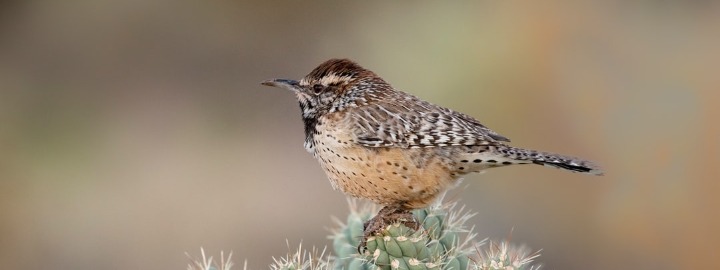Big and Brash, These Desert Birds Personify the Spirit of the West
Most states share designated state birds with one or more other states, but not Arizona. Reflecting western independence, Arizona stands alone with the Cactus Wren.
Well known as a premier birding destination, Arizona is home to 23 of the 28 birds adopted by the 50 United States as official state birds. Unlike most of those other states, however, Arizona chose to select a unique bird, unnamed by any other state.
Official State Birds of the 50 United States
After the first state (Delaware) ratified the constitution on December 7, 1787, 139 years passed before one state-designated a state bird. In 1926, Kentucky chose the Northern Cardinal as its state bird. Other states soon selected state birds, as well, and now all 50 states and the District of Columbia have official state birds.
That first bird, the Northern Cardinal (Cardinalis cardinalis) proved to be the most popular choice, with six other states also selecting it. Interestingly, each of those seven states shares borders with at least one of the other six, and Kentucky borders five of the six other states that selected the Cardinal.
This propensity to select an official bird already named by another state continued throughout the process until 30 states now share just 8 species. The second most popular choice is the Western Meadowlark, named by six states, just one more than the five that chose the Northern Mockingbird. The American Robin and the American Goldfinch were both selected by three states, and the Mountain Bluebird, Eastern Bluebird, and the Black-capped Chickadee were each chosen by two states.
Only 20 states stand alone with a state bird not named elsewhere, and Arizona, with the Cactus Wren, is one of these.
The Cactus Wren (Campylorhynchus brunneicapillus)
There is nothing subtle about the Cactus Wren. The other eight wrens found in North America bear a lot in common. Generally speaking, they are small, mostly drab and brown, as well as shy and furtive. They also are melodious singers. None of the eight, incidentally, have been named as state birds. The Cactus Wren, on the other hand, is big, boisterous and brash. At 8 1/2 inches, he is larger than any of the other wrens. His name is also bigger than that of any other wren, a vocal-challenging 10 syllables, Campylorhynchus brunneicapillus, which means “curved bill”.
Cactus Wrens are boldly patterned, and, unlike its evasive fellow wrens, brashly societal and inquisitive. They are noisy, as well, but their song is anything but melodious. David Sibley, in The National Audubon Society’s The Sibley Guide to Birds, describes the wren’s song as “low, grating, chugging and unmusical”, and its call as “dry, clicking…..harsh, like a quacking duck.” They also have a mean streak, and will destroy the eggs and nests of other birds, including other Cactus Wrens, and have been observed killing House Finches with their sharp bill.
Cactus Wrens are non-migratory desert dwellers, common only to four states, California, Arizona, New Mexico and Texas. They build multiple nests, usually in spiny cholla cactus, and most of these nests are never occupied by the builders. Typically they have two, sometimes three, broods per year, with three to four eggs each. They are mostly monogamous, and they “growl” when they greet their mates. Their eggs incubate in about 16 days, and the altricial young fledge three weeks later.
Although a desert dweller, like the Greater Roadrunner and the Verdin, the Cactus Wren’s friendly curiosity brings it into suburban neighborhoods, as well. Primarily an insect eater, it can be attracted to home yards with suet feeders, and, once there, it is likely to stick around.
Arizona’s Bold Choice for State Bird
Arizona was the last of the lower 48 states to join the union, on Valentine’s Day in 1912. Rugged individualism characterizes much about this southwestern state, and its selection of the bold and brash Cactus Wren as state bird fits this attitude well.

